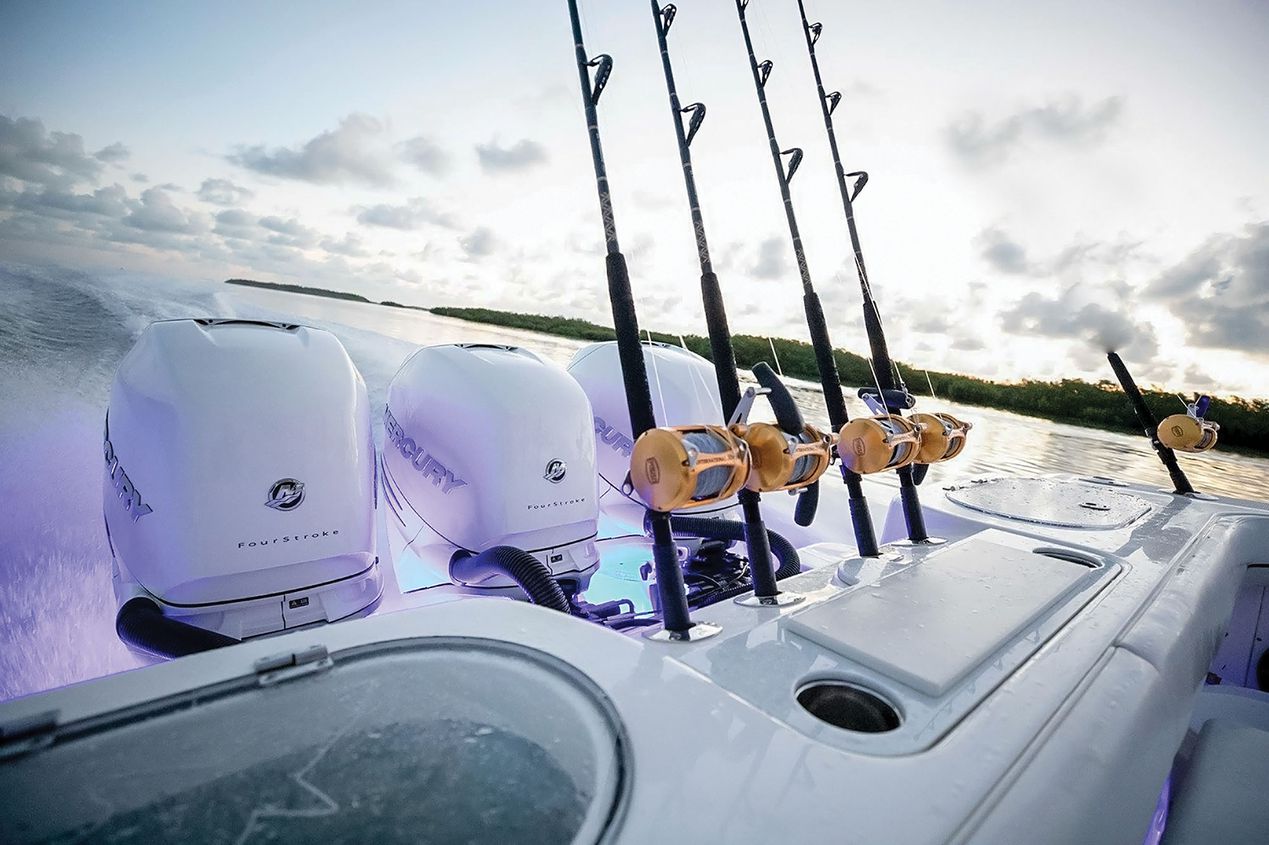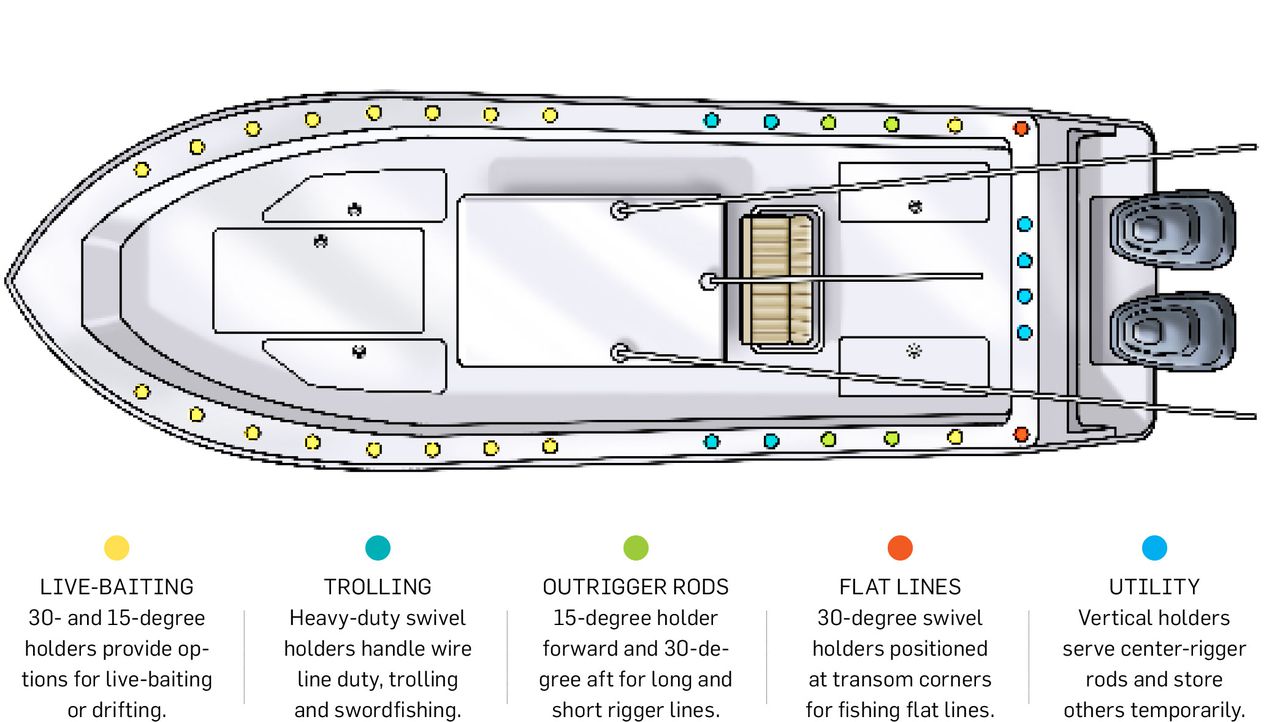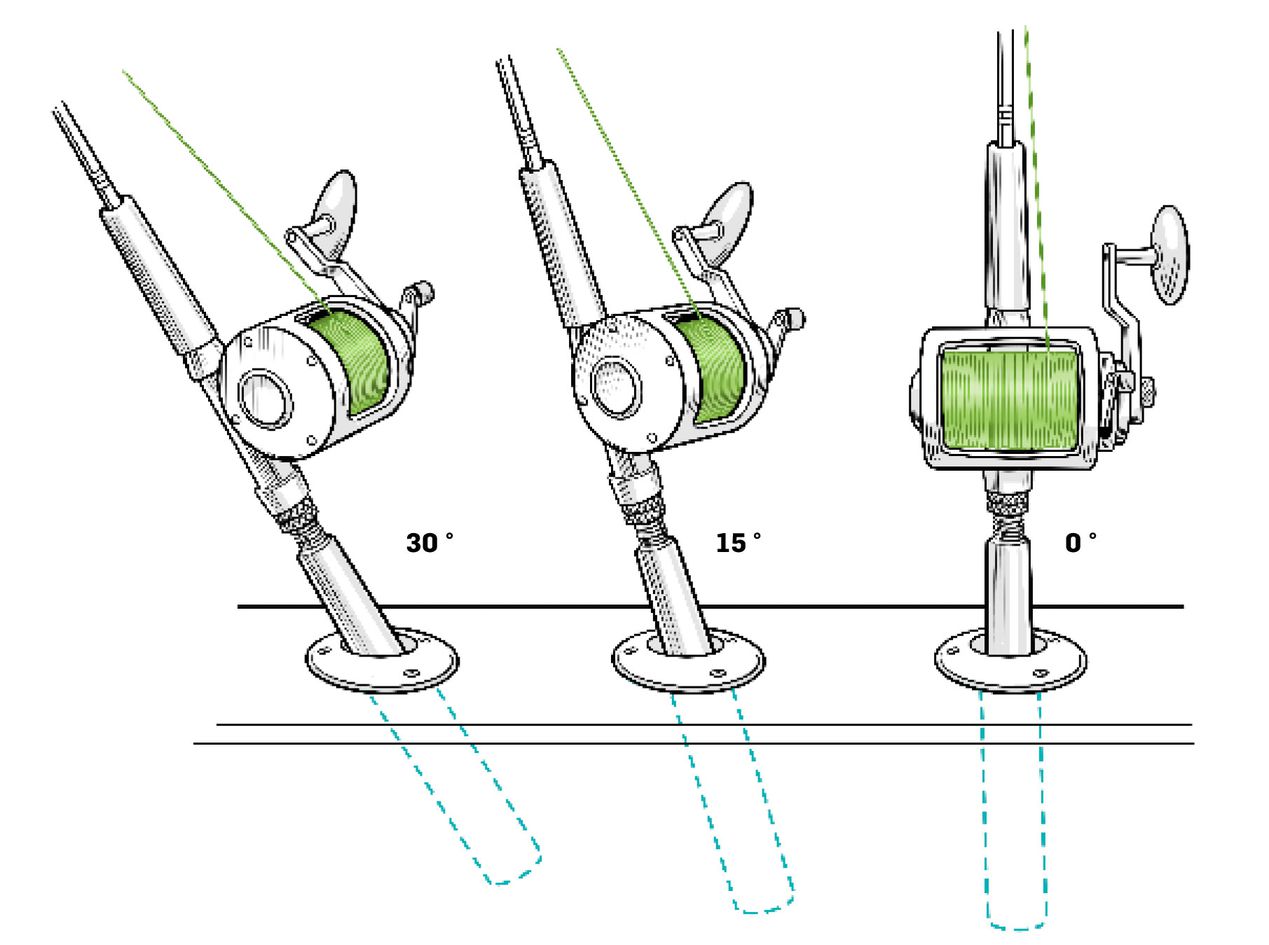Celebrating
|
How to Place Rod Holders in Your Boat
|
| Effective placement leads to more efficient fishing. |
| by George Poveromo |
| RETURN TO HOW TO'S MAIN PAGE - CLICK HERE |
|
|
| Rod-holder positioning defines angler caliber. While a couple of pairs of transom-mounted aft-facing holders might suffice for light trolling, they’ll prove inadequate for a full spread of trolling baits. It’s not only a numbers game with rod holders. Precisely placing holders complements your fishing style. |
| Dragging Baits The larger and more finely tuned a bait spread, the more potent it will be at raising fish. For example, my Mako 334 center-console can troll a maximum of eight rods, not counting teasers. This was accomplished by first mounting three rod holders per side, in the aft covering boards. Prior to their installation, and that of the remaining holders, I outlined exactly where they would go. A pair of 30-degree stainless-steel Lee swivel rod holders (one per side) would be positioned farthest aft, just to the outside of each transom livewell. These would be for flat-line deployments. Roughly 3 feet forward from those would be another pair of 30-degree Lee swivel rod holders for the short outrigger baits and another 3 feet forward from them, and offset outboard, would be a pair of Lee 15-degree flush-mount rod holders for the long outrigger baits. The four heavy-duty swivel rod holders (two per side), in addition to general trolling chores, handle the rigors of wire-line trolling for wahoo and groupers, as well as swordfishing. What’s more, the ability to set them—as well as the offset 15-degree flush-mount holders—at angles would help avoid line-to-rod contact upon strikes. Distance between the rods, offsetting, and angle adjustments are a must to keep a clean and hindrance-free trolling setup. Marc VI can troll eight lines. Three aft rod holders per side account for six outfits. The center rigger, accommodating the remaining two lines, sets one bait way, way back and one up close, which skips dead center behind the prop wash. The center rigger outfits are positioned in two of the four zero-degree center-transom holders. The reason for zero-degree holders here, where the rods ride straight up, is for clearance when the outboards are trimmed up. The boat’s trolling versatility isn’t just confined to offshore and outriggers. A couple of seasons back, I had my boat in Atlantic City, New Jersey, where Tom Daffin and I pursued a late November push of big striped bass. Pulling MoJos and Rapala Mag 40 plugs from five gunwale- and center-transom-based outfits, our highlight was hooking five big stripers simultaneously. One eventually shook free, but a double on one of my rods still enabled us to score five releases on that pass through a bunker school. The arrangement of the rod holders kept all five lines well apart and their lures tracking within their own zones without relying on the outriggers. |
|
|
| Live-Baiting The flexibility of center-consoles enables them to be dialed in for various fishing styles. When in a live-baiting/drifting mode, our aft bait fishes from a 15-degree holder positioned 90 degrees outboard. Forward of the trolling rod holders, beginning nearly even with the front of the console, are eight holders per side. Aimed seaward, most are 15-degree flush-mount holders, with the exception of two pairs of swivel holders positioned far forward. The reason for the latter is the flexibility to use heavy tackle when fishing or fighting a large fish from the bow. When drifting, this rod-holder arrangement allows maximum water coverage. For example, on the downwind side of the boat, we’ll fly a kite with three baits, and sometimes two kites, putting three to six live baits splashing enticingly off the bow and stern. A kite station is based in the bow as well as within the cockpit. Sometimes we’ll add a trident holder to the mix, though it’s not always necessary. On the upwind side, we often deploy a pair live baits on the surface, one from the aft holder positioned at 90 degrees (directly seaward), and one from the farthest-forward swivel rod holder. With outfits at opposite ends of the boat, their respective live baits spread out better (read: reduced tangles). A pair of deep baits is also part of the mix: one positioned close to the bow, the other closer to the cockpit. In between this spread, we occasionally free-line a live bait, slowly retrieved and free-lined again. |
|
|
| Bottom-Bumping These same rod-holder placements are ideal for bottomfishing: Several rods can be fished simultaneously, even with two anglers. A perfect example of this occurred in May, when Carl Grassi and I took Marc VI to the Green Turtle Club in Abaco, Bahamas. We set up drifts between 60 and 200 feet of water. From the cockpit, I dropped a 10-ounce jig tipped with a ballyhoo, while Grassi pitched a lighter jig-and-ballyhoo combo up-current, let it sink to bottom, then worked it as the boat drifted toward it. Two additional rods joined the mix: two gunwale-based outfits with live baits, one midcolumn for pelagics, the other closer to bottom for groupers and snappers. I then added a third outfit, one with a 40-foot leader and fresh ballyhoo, for mutton snapper. Basically, the well-positioned rod holders enabled us to fish up to five outfits at once. After three -action-packed hours, we ended up with a big black grouper, a large yellowfin grouper, scamp, red and strawberry groupers, and three hefty muttons. |
| Get on Your Game These examples showcase some of the ways I fish and how a well-thought-out rod-holder arrangement complements these efforts. However, there are numerous ways to incorporate extra rod holders on a boat, such as offset mounts on a T-top, which, similar to outriggers, help spread baits, or holders that fasten onto bow rails for drifting. Remember: A well-fitted boat can never have too many rod holders. The trick is understanding how additional holders benefit your style of fishing, then placing them wisely. This includes their angle (often necessary for clearance) and positioning so they don’t interfere with each other. Done properly, it’s like having a full crew aboard. |
| RETURN TO HOW TO'S MAIN PAGE - CLICK HERE |




